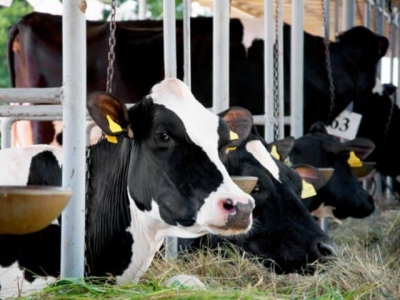Feed additive may cut cow methane emissions, boosts daily gain

A dairy cow methane inhibitor may work long-term, improve daily weight gain and boost milk protein and lactose production, researchers report.
The international group of researchers was looking for a way to reduce methane emissions without negatively effecting feed intake or milk production, Alexander Hristov, professor of dairy nutrition at Pennsylvania State University told FeedNavigator.
“Livestock contribution to man-made methane emissions in the US is around 25%, so it is important to try to mitigate these emissions, if we are concerned about the environment,” Hristov said. “We have to keep in mind, however, that of all greenhouse gas emissions, those from animal agriculture are still very low, around 3% in the US.”
In addition to contributing to anthropogenic greenhouse gas emission in the US, methane production is a loss of feed energy for animals, explained the study researchers in PNAS. They tested the effects of supplemental 3-niitroozypropanol (3NOP) as a methane-reducing additive.
“The experiment demonstrated that the methane inhibitor 3NOP, applied at 40 to 80 mg/kg feed dry matter, decreased methane emissions from high-producing dairy cows by 30% and increased body weight gain without negatively affecting feed intake or milk production and composition. The inhibitory effect persisted over 12 weeks of treatment, thus offering an effective methane mitigation practice for the livestock industries,” researchers reported.
“In the current experiment, digestibility of most dietary nutrients was increased by the 3NOP treatment, which may have also contributed to the greater body weight gain of the treated cows, compared with the control cows,” they added.
The team of researchers included members from Pennsylvania State University, Maringá State University in Brazil, the agriculture research division of the Department of Economic Development, Jobs, Transport and Resources in Australia and included employees from DSM Nutritional Products. The company partially funded the research.
’Surprise’
The research also showed that cows receiving the supplement gained about 168 g/d more than the control cows. And, the apparent total tract digestibility of dry matter, crude protein, organic matter and acid-detergent fiber increased quadratically for the cows getting the additive.
“I was personally expecting a smaller effect of the compound and was very surprised how effective it was and how persistent the effect was,” said Hristov. “It was also very important that fiber digestibility, feed intake and milk production (in these high-producing cows) were not affected.”
Unique study elements
Although different supplements have demonstrated the ability to reduce the amount of methane produced by dairy cattle, they tend to be short-term, limit feed intake, decrease animal productivity, increase the difficulty of digesting fiber, or the animal’s rumen archaea has adapted to the additive, researchers said.
Previous studies using 3NOP studied its effectiveness in sheep, cattle and dairy cows, but did not examine the effect on lactating dairy cows, they said.
“The study we report here is, to our knowledge, the first investigating 3NOP in a long-term experiment with cows fed a typical North American diet and with milk production comparable to high-producing dairy herds in the US,” they said. “Under these conditions, 3NOP reduced methane emission by up to 30%, a remarkable effect that was maintained throughout the 12-wk experiment.”
What’s next?
Although the initial results are promising, said Hristov, longer-term trials are needed to ensure that the treatment remains effective and that the “rumen ecosystem” doesn’t adapt to it.
“Next we hope to conduct an FDA approval study,” he said. “It is also important to find out if the extra energy saved has an effect on cow reproduction and milk production and composition in early lactation.”
If the additive is approved for use, it could be about a year before it is available for public use, he added.
Có thể bạn quan tâm
 Method converts dairy waste water to animal feed, fuel
Method converts dairy waste water to animal feed, fuel A University of Tübingen biotechnologist seeks to recycle waste with the ultimate aim of creating a sustainable cycle of materials.
 What role does ruminal microbiome plays in determining feed efficiency?
What role does ruminal microbiome plays in determining feed efficiency? A research team at the University of Wyoming has received a $500,000 grant to study rumen microbes with an eye toward improving feed efficiency.
 US researchers use prebiotics, probiotics and milk intake to improve calf health
US researchers use prebiotics, probiotics and milk intake to improve calf health Dairy calves may see long-term benefits from use of prebiotics or probiotics and additional milk replacer intake, say scientists based at Texas Tech University